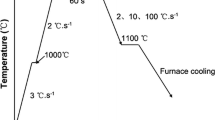Abstract
A physical model for determining the relative amount of phase components and the size of ferrite grains after decomposition of austenite in the process of cooling of double-phase steels is suggested. The main products of austenite transformation, i.e., polygonal ferrite, pearlite, bainite, and martensite, are considered. The driving forces of the transformation and the concentration of carbon on the phase surface are determined with the use of methods of computational thermodynamics. The model is based on equations of the classical theory of nucleation and growth. It allows for the structural features of the occurrence of γ → α transformation and contain some empirical parameters. The latter are determined using data of dilatometric measurements of the kinetics of austenite transformation and metallographic measurements of the size of ferrite grains. The model is used for predicting the kinetics of the transformation under the complex cooling conditions implemented by the VOEST-ALPINE STAHL LINZ GmbH rolling mill within the computer system for control of mechanical properties of hot-rolled strip.
Similar content being viewed by others
References
J. Andorfer, D. Auzinger, G. Hribernig, et al., “Modeling of austenite decomposition of hot-rolled plain carbon steels under complex cooling conditions,” Steel Res., 71(200), 118–123 (2000).
A. N. Samoilov, G. Hribernig, Yu. F. Titovets, and N. Yu. Zolotarevsky, “On the modeling of pearlite reaction in steels,” in: Proc. Int. Symp. “Transformation and Deformation Mechanism in Advanced High Strength Steels,” COM2003, 23–27 Aug. 2003, Vancouver, Canada (2003), pp. 161–170.
A. Samoilov, Yu. F. Titovets, N. Yu. Zolotarevsky, and G. Hribernig, “CATRAN — a multi-task physical model and computer program for the prediction of the microstructure of steels according to an arbitrary cooling schedule,” Mat. Sci. Forum, 426–432, 1189–1194 (2003).
A. Samoilov, Yu. Titovets, N. Zolotarevsky, et al., “Cr influence on steel microstructure and kinetics of austenite decomposition at near-bay temperatures,” in: Proc. Int. Conf. on Microalloying for New Steel Processes and Applications, Microalloying’2005 San-Sebastian (2005), pp. 311–319.
Y. Van Leevwen, S. Vooijs, J. Sietsma, and S. Van der Zwaag, “The effect of geometrical assumptions in modeling solid-state transformation kinetics,” Metall. Mater. Trans. A, 29A, 2925–2931 (1998).
M. Militzer, R. Pandi, and E. B. Hawbolt, “Ferrite nucleation and growth during continuous cooling,” Metall. Mater. Trans. A, 27A, 1547–1556 (1996).
J. W. Christian, Transformations in Metals and Alloys, Part 1, Pergamon Press, Oxford (1975).
Y. Saito and C. Shiga, “Computer simulation of microstructural evolution in thermomechanical processing of steel plates,” ISIJ Int., 32, 414–422 (1992).
K. Lee, J. Lee, K. Kang, and O. Kwon, “Modeling of γ/α transformation in microalloyed steels,” in: Int. Conf. Computer Assisted Materials Design and Process Simulation, ISIJ, Tokyo (1993), pp. 374–379.
B. Ya. Lyubov, The Kinetic Theory of Phase Transformations [in Russian], Metallurgiya, Moscow (1969).
G. R. Purdy and Y. J. M. Brechet, “A solute drag treatment of the effect of alloying elements on the rate of the proeutectoid ferrite transformation in steels,” Acta Metall. Mater., 43, 3763–3774 (1995).
M. P. Puls and J. S. Kirkaldy, “The pearlite reaction,” Metall. Trans., 3, 2777–2796 (1972).
H. I. Aaronson, G. Spanso, R. A. Masamura, et al., “Sympathetic nucleation: an overview,” Mater. Sci. Eng., B32, 107–123 (1995).
S. E. Offerman, N. H. Van Dijk, J. Sietsma, et al., “Solid-state phase transformations involving solute partitioning: modeling and measuring on the level of individual grains,” Acta Mater., 25, 4757–4766 (2004).
G. Spanos, A. W. Wilson, and M. V. Kral, “New insight into Widmanstätten proeutectoid ferrite transformation: integration of crystallographic and three-dimensional morphological observation,” Metall. Mater. Trans. A, 36A, 1209–1218 (2005).
H. K. D. H. Bhadeshia, Bainite in Steels, The Institute of Materials, London, UK (1992).
D. Quidort and Y. J. M. Brechet, “Isothermal growth kinetics of bainite in 0.5% C steels,” Acta Mater., 49, 4161–4170 (2001).
H. Ohtani, S. Okaguchi, Y. Fujishiro, and Y. Ohmori, “Morphology and properties of low-carbon bainite,” Metall. Trans. A, 21A, 877–888 (1990).
H. I. Aaronson, W. T. Reynolds, and G. R. Purdy, “Coupled-solute drag effects on ferrite formation in Fe-C-X systems,” Metall. Mater. Trans. A, 35A, 1187–1210 (2004).
V. M. Schastlivtsev, “New concepts of the nature of bainite transformation in steels,” Metalloved. Term. Obrab. Met., No. 8, 24–29 (2005).
V. V. Rybin, I. P. Kursevich, E. V. Nesterova, and M. S. Mikhailov, “Structure and mechanical properties of little activated heat-resistant reactor steel,” Metalloved. Term. Obrab. Met., No. 7, 69–77 (2005).
D. A. Mirzaev, K. Yu. Okishev, V. M. Schastlivtsev, and I. L. Yakovleva, “The kinetics of formation of bainite and lath martensite. III. Bainite transformation in alloy Fe-9% Cr,” Fiz. Met. Metalloved., 90, 72–82 (2000).
D. Quidort and Y. J. M. Brechet, “A model of isothermal and nonisothermal transformation kinetics of bainite in 0.5% C steels,” ISIJ Int., 42, 1010–1016 (2002).
M. Hillert and L. Höglund, “The bay phenomenon in steels with reasonably strong carbide formers,” in: Materials Science and Technology 2003, ISS and TMS, USA (2003), pp. 3–14.
Q. Bouaziz, D. Quidort, and P. Maugis, “Bainite transformation stasis controlled by plastic work in austenite,” Revue de Metallurgie-CIT, No. 1, 103–108 (2003).
Yu. F. Titovets, N. Yu. Zolotarevsky, A. N. Samoilov, et al., “Modeling of bainite transformation in low-alloy steels,” Vopr. Materialoved., 47(3), 5–12 (2006).
Yu. F. Titovets, N. Yu. Zolotarevsky, A. N. Samoilov, et al., “A study of the effect of chromium on the structure and kinetics of bainite transformation in low-alloy steels,” Vopr. Materialoved., 47(3), 13–22 (2006).
Author information
Authors and Affiliations
Additional information
__________
Translated from Metallovedenie i Termicheskaya Obrabotka Metallov, No. 1, pp. 16–23, January, 2007.
Rights and permissions
About this article
Cite this article
Zolotarevskii, N.Y., Titovets, Y.F., Samoilov, A.N. et al. Modeling of structure of double-phase low-carbon chromium steels. Met Sci Heat Treat 49, 10–16 (2007). https://doi.org/10.1007/s11041-007-0002-0
Issue Date:
DOI: https://doi.org/10.1007/s11041-007-0002-0




